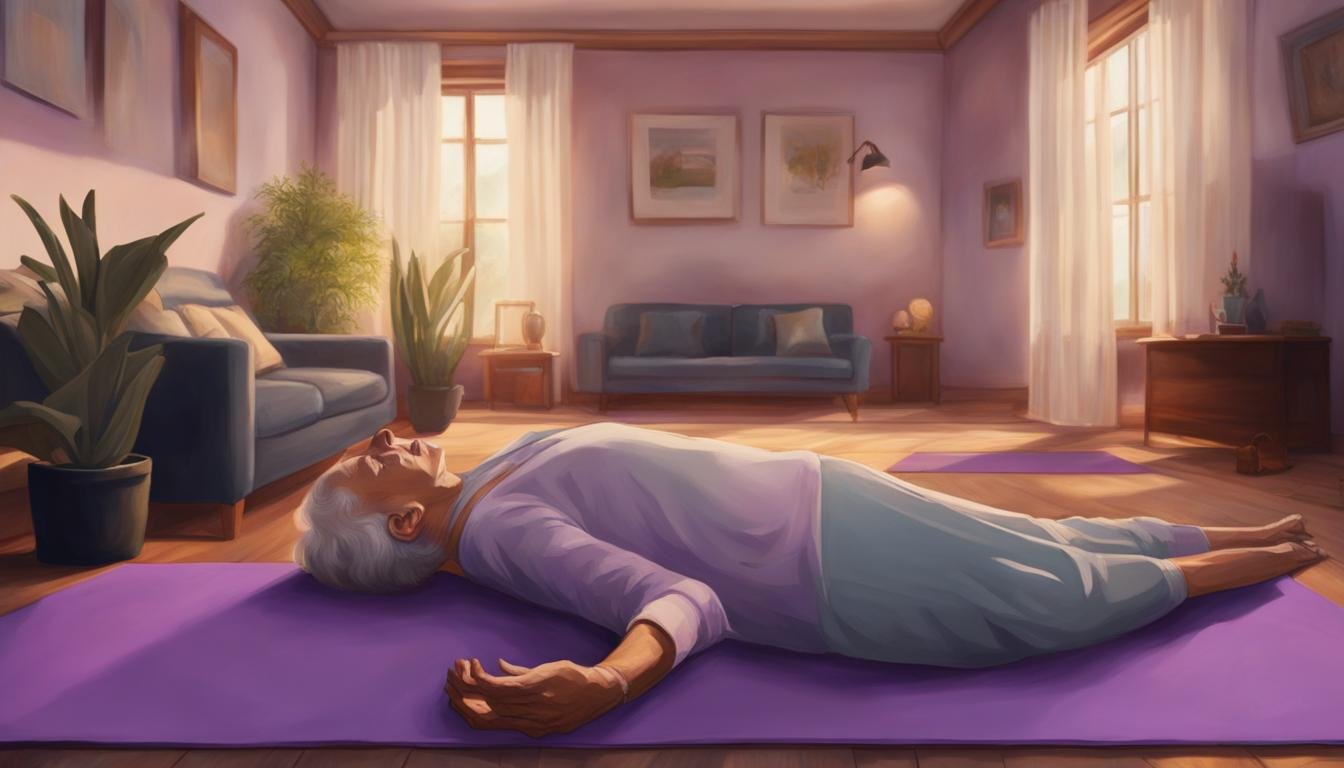As seniors, achieving a good night’s sleep can sometimes feel elusive. Sleep disturbances become more common with age, affecting both the quality and duration of sleep. However, there is a natural and effective solution to improve sleep in seniors – yoga. Research has shown that regular yoga practice can have a positive impact on sleep by reducing stress, promoting relaxation, enhancing mindfulness, and alleviating physical discomfort.
Key Takeaways:
- Regular yoga practice can help seniors achieve better sleep by reducing stress and promoting relaxation.
- Yoga can improve mindfulness, allowing seniors to quiet the mind and prepare for sleep.
- Gentle stretching and relaxation techniques in yoga can help release tension in the body, leading to improved sleep quality.
- Specific yoga poses, such as Corpse Pose and Legs-Up-the-Wall Pose, can promote better sleep in seniors.
- Seniors should consult with a qualified yoga instructor to ensure safe and appropriate modifications.
Understanding the Impact of Sleep Disturbances in Seniors
As seniors age, sleep disturbances become increasingly common and can have a significant impact on their overall health and quality of life. Many older adults experience difficulties falling asleep, staying asleep, or waking up too early, leading to chronic sleep problems. These sleep disturbances contribute to an increased risk of chronic diseases, cognitive decline, depression, and reduced quality of life.
It is crucial to address these sleep issues in seniors to improve their well-being. One effective approach is through the practice of yoga. Yoga offers a holistic solution that targets both the physical and mental aspects of sleep. Regular yoga practice has been shown to reduce stress, improve relaxation, promote mindfulness, and alleviate physical discomfort, all of which can contribute to better sleep quality in seniors.
“Yoga offers a holistic solution that targets both the physical and mental aspects of sleep.”
By incorporating yoga into their routine, seniors can benefit from improved sleep duration, sleep efficiency, and overall sleep quality. Yoga can help regulate the circadian rhythm, promote relaxation, and reduce hyperarousal. The gentle stretching and relaxation techniques involved in yoga help seniors release tension in the body and calm the mind, creating an environment conducive to better sleep. Additionally, practicing yoga before bedtime can establish a bedtime routine that signals to the body and mind that it’s time to relax and prepare for sleep.
| Benefits of Yoga for Seniors: | Sleep Improvement through Yoga: | Yoga for Older Adults and Sleep: |
|---|---|---|
| Promotes relaxation | Regulates circadian rhythm | Targets physical and mental aspects of sleep |
| Reduces stress | Promotes better sleep quality | Alleviates physical discomfort |
| Improves mindfulness | Enhances sleep duration | Creates a bedtime routine |
In conclusion, sleep disturbances have a significant impact on the health and well-being of seniors. Incorporating yoga into their routine offers a holistic approach to addressing these sleep issues. Yoga can provide seniors with the tools to reduce stress, improve relaxation, promote mindfulness, and alleviate physical discomfort, all of which contribute to better sleep quality. By embracing a regular yoga practice, seniors can enhance their sleep duration, sleep efficiency, and overall sleep quality, leading to improved health and well-being.
The Link Between Yoga and Better Sleep
Yoga has been found to be an effective practice for improving sleep in seniors. Regular yoga practice can help regulate the circadian rhythm, promote relaxation, and reduce hyperarousal. The gentle stretching and relaxation techniques involved in yoga can help seniors release tension in the body and calm the mind, leading to improved sleep quality and duration. Additionally, practicing yoga before bedtime can help create a bedtime routine that signals to the body and mind that it’s time to relax and prepare for sleep.
Seniors who incorporate yoga into their sleep routine can experience a variety of benefits. Yoga is a senior-friendly activity that can be modified to accommodate individual mobility and health concerns. By engaging in a regular yoga routine for better sleep, seniors can promote a sense of well-being and enhance their overall sleep quality.
One study conducted on senior participants who practiced yoga for six months found that they experienced significant improvements in sleep quality, reduced sleep disturbances, and increased sleep efficiency. These findings highlight the positive impact yoga can have on sleep for seniors. By incorporating yoga into their daily or weekly routine, seniors can enjoy the restful sleep they deserve.
Yoga Routine for Better Sleep in Seniors
When establishing a yoga routine for better sleep in seniors, it’s important to choose poses that promote relaxation and help release tension in the body. Here are some recommended yoga poses that can aid in better sleep:
| Yoga Pose | Description |
|---|---|
| Corpse Pose (Savasana) | A pose of complete relaxation, lying flat on the back with arms and legs extended, allowing the body and mind to fully let go. |
| Legs-Up-the-Wall Pose (Viparita Karani) | By placing the legs up against a wall while lying flat on the back, this pose promotes relaxation and helps improve circulation. |
| Child’s Pose (Balasana) | A gentle forward fold pose that stretches the lower back and promotes relaxation and calmness. |
| Reclined Spinal Twist (Supta Matsyendrasana) | A supine twist that stretches the spine and releases tension in the back and hips, aiding in relaxation and promoting better sleep. |
It’s important for seniors to work with a qualified yoga instructor who can provide modifications for any specific health concerns or limitations. The instructor can help seniors achieve proper alignment and ensure their yoga practice is safe and effective for better sleep.
Recommended Yoga Poses for Better Sleep in Seniors
When it comes to promoting better sleep in seniors, certain yoga poses have proven to be particularly effective. These poses help seniors relax, release tension, and prepare their bodies for a restful night’s sleep. Here are some recommended yoga poses for better sleep in seniors:
Corpse Pose (Savasana)
The Corpse Pose, also known as Savasana, is a deeply relaxing and rejuvenating pose that helps seniors unwind before sleep. By lying flat on their backs with arms and legs relaxed, seniors can release physical and mental tension, calming their minds and preparing for a peaceful slumber.
Legs-Up-the-Wall Pose (Viparita Karani)
The Legs-Up-the-Wall Pose, or Viparita Karani, is a gentle inversion pose that promotes relaxation and improved blood circulation. Seniors can lie on their backs near a wall and extend their legs upward, allowing gravity to assist in reducing swelling and promoting a sense of calmness conducive to sleep.
Child’s Pose (Balasana)
The Child’s Pose, or Balasana, is a restorative pose that gently stretches the lower back, hips, and thighs. Seniors can kneel on the floor, folding their upper body forward and extending their arms in front of them. This pose helps release tension in the body and activates the relaxation response, aiding in better sleep.
Reclined Spinal Twist (Supta Matsyendrasana)
The Reclined Spinal Twist, or Supta Matsyendrasana, is a soothing twist that helps seniors release tension in the spine and hips. By lying on their backs and gently twisting their legs to one side while keeping their shoulders grounded, seniors can alleviate back discomfort and prepare their bodies for a restful night’s sleep.
It’s important for seniors to work with a qualified yoga instructor when practicing these poses, ensuring proper alignment and modifications to accommodate any specific health concerns or limitations. Consistency in practicing these poses, along with other yoga techniques, can contribute to improved sleep quality and overall well-being in seniors.
Chair Yoga for Better Sleep
Chair yoga is a modified form of yoga that is specifically designed for seniors and individuals with limited mobility. It offers a safe and accessible way for older adults to experience the benefits of yoga, including improved sleep. Chair yoga poses can be done while seated or using the support of a chair, making it ideal for seniors who may have difficulty with traditional yoga poses. By incorporating chair yoga into their daily routine, seniors can enhance their sleep quality and promote relaxation.
Some chair yoga poses that are particularly beneficial for better sleep in seniors include the Seated Forward Bend, Seated Spinal Twist, and Seated Cat-Cow. These poses help seniors improve flexibility, release tension in the body, and promote relaxation, which can contribute to a more restful sleep. Chair yoga also focuses on deep breathing exercises and mindfulness, which can help seniors calm their minds and prepare for sleep.
When practicing chair yoga for better sleep, it is important for seniors to work with a qualified yoga instructor who can provide guidance and modifications based on individual needs and abilities. The instructor can help seniors find the right balance between effort and relaxation and ensure proper alignment to prevent any strain or injury. With regular practice and guidance, chair yoga can become an enjoyable and effective part of a senior’s sleep routine.
Table: Chair Yoga Poses for Better Sleep
| Chair Yoga Pose | Description |
|---|---|
| Seated Forward Bend | A gentle forward bend that stretches the back and hamstrings, promoting relaxation and releasing tension in the body. |
| Seated Spinal Twist | A twisting pose that helps improve spinal mobility, release tension in the spine, and stimulate digestion, promoting relaxation before sleep. |
| Seated Cat-Cow | A gentle flowing movement between rounding and arching the spine while seated, promoting flexibility and relaxation in the back and torso. |
Chair yoga offers a convenient and effective way for seniors to incorporate yoga into their sleep routine. By practicing senior-friendly poses and focusing on deep breathing and mindfulness, seniors can experience the benefits of yoga for better sleep. Regular chair yoga practice can lead to improved sleep quality, reduced sleep disturbances, and enhanced overall well-being in seniors.
The Importance of Mindfulness and Breathing Exercises
Mindfulness and breathing exercises are integral components of a yoga practice aimed at improving sleep in seniors. By incorporating these practices into their bedtime routine, seniors can effectively quiet their minds and promote relaxation, ultimately facilitating a smoother transition into sleep.
Mindfulness, which involves being fully present in the moment without judgment, allows seniors to let go of any worries or anxieties that may disrupt their sleep. By redirecting their attention to their breath or the sensations in their body, seniors can shift their focus away from racing thoughts and achieve a sense of calm.
“Mindful awareness of the present moment and focused breathing can help seniors relax, reduce stress, and quiet the mind before sleep.”
Breathing exercises, such as deep belly breathing and alternate nostril breathing, have a profound impact on the body’s relaxation response. These techniques activate the parasympathetic nervous system, which promotes a state of relaxation and calm, counteracting the effects of stress and anxiety that may hinder sleep.
The Benefits of Mindfulness and Breathing Exercises for Sleep in Seniors
- Promote relaxation and reduce stress levels
- Quiet the mind and reduce racing thoughts
- Activate the parasympathetic nervous system, inducing relaxation
- Improve breathing patterns, enhancing oxygenation and relaxation
- Enhance overall sleep quality and duration
By embracing mindfulness and incorporating breathing exercises into their yoga practice for better sleep, seniors can create a peaceful and conducive environment for restful sleep. It is essential for seniors to commit to consistent practice and seek guidance from qualified instructors to reap the full benefits of these techniques.
| Mindfulness and Breathing Techniques | Benefits |
|---|---|
| Deep belly breathing | Promotes relaxation and reduces stress levels |
| Alternate nostril breathing | Calms the mind, balances energy, and induces relaxation |
| Mindful body scan | Enhances body awareness and promotes relaxation |
| 4-7-8 breathing | Regulates breathing and activates relaxation response |
| Mindful breathing meditation | Quiets the mind, reduces racing thoughts, and induces sleep |
Yoga and Lifestyle Factors that Improve Sleep in Seniors
In addition to the physical practice of yoga, there are several lifestyle factors that can further enhance its benefits for promoting sleep in seniors. By adopting these factors, seniors can optimize their sleep quality and overall well-being.
Consistent Sleep Schedule
One important lifestyle factor is maintaining a consistent sleep schedule. Going to bed and waking up at the same time every day helps regulate the body’s internal clock, making it easier to fall asleep and wake up naturally. Seniors should aim for a minimum of seven to eight hours of sleep each night.
Relaxing Sleep Environment
The sleep environment plays a crucial role in promoting quality sleep. Seniors should create a relaxing sleep environment that is cool, quiet, and dark. Using blackout curtains, earplugs, or white noise machines can help block out any external disturbances.
Limiting Electronic Device Use
Electronic devices emit blue light, which can interfere with the body’s natural sleep-wake cycle. Seniors should limit their use of electronic devices, such as smartphones, tablets, and TVs, at least one hour before bedtime. Instead, they can engage in calming activities such as reading a book or listening to soft music.
Good Sleep Hygiene
Practicing good sleep hygiene habits can also contribute to better sleep in seniors. This includes avoiding heavy meals and caffeine close to bedtime, engaging in regular physical activity during the day, and creating a relaxing bedtime routine that incorporates mindfulness and breathing exercises.
By incorporating these lifestyle factors into their daily routine along with yoga practice, seniors can create an optimal sleep environment and set the stage for a restful night’s sleep.
| Lifestyle Factors | Benefits |
|---|---|
| Consistent Sleep Schedule | Regulates the body’s internal clock |
| Relaxing Sleep Environment | Reduces external disturbances |
| Limiting Electronic Device Use | Minimizes blue light exposure |
| Good Sleep Hygiene | Promotes healthy sleep habits |
Research on Yoga’s Effectiveness for Sleep Improvement in Seniors
Research studies have provided strong evidence supporting the benefits of yoga for sleep improvement in seniors. These studies have shown that regular yoga practice can have a positive impact on sleep quality, duration, and efficiency in older adults. By incorporating yoga into their routine, seniors can experience improved sleep and overall well-being.
A study published in the Journal of Clinical Sleep Medicine found that a 12-week yoga intervention significantly improved both subjective and objective measures of sleep quality in older adults with insomnia. Another study conducted by the Department of Psychiatry at the University of California, Los Angeles, showed that a yoga program improved sleep efficiency and reduced symptoms of insomnia in seniors.
Additionally, research has shown that yoga can reduce the use of sleep medications in older adults. A study published in the Journal of the American Geriatrics Society found that a gentle yoga program led to a significant decrease in the use of sleep medications among seniors with insomnia. This highlights the potential of yoga as a non-pharmacological approach to managing sleep disturbances in the aging population.
The Benefits of Yoga for Seniors
- Improved sleep quality
- Enhanced sleep duration
- Reduced symptoms of insomnia
- Decreased use of sleep medications
These findings support the inclusion of yoga in the sleep routine of seniors seeking to improve their sleep. It is important to note that yoga should be practiced under the guidance of a qualified instructor to ensure safety and proper alignment. Seniors should consult with their healthcare professional before starting any new exercise program, including yoga, to determine if it is suitable for their individual needs.
By incorporating yoga into their routine, seniors can experience the holistic benefits of this ancient practice, including improved sleep, reduced stress, increased relaxation, and enhanced overall well-being.
| Study | Findings |
|---|---|
| Journal of Clinical Sleep Medicine | A 12-week yoga intervention significantly improved sleep quality in older adults with insomnia. |
| Department of Psychiatry, UCLA | A yoga program improved sleep efficiency and reduced symptoms of insomnia in seniors. |
| Journal of the American Geriatrics Society | A gentle yoga program led to a significant decrease in the use of sleep medications among seniors with insomnia. |
Tips for Starting a Yoga Routine for Better Sleep in Seniors
Starting a yoga routine for better sleep in seniors can be a beneficial and enjoyable practice. However, it is important to approach it with caution and guidance to ensure safety and maximize the benefits. Here are some tips to help seniors get started on their yoga journey:
1. Consult with a healthcare professional:
Before beginning any new exercise program, including yoga, seniors should consult with their healthcare professional. This will help ensure that yoga is safe and appropriate for their individual health needs and any specific conditions or concerns they may have.
2. Work with a qualified yoga instructor:
It is highly recommended to work with a qualified yoga instructor, especially one who has experience in teaching senior-friendly yoga for sleep. A knowledgeable instructor can tailor the yoga practice to meet the individual needs and abilities of seniors, provide modifications for any specific health concerns, and guide them safely through the poses and sequences.
3. Start slow and gradually increase:
Seniors should start their yoga practice slowly and gradually increase the intensity and duration of their sessions over time. It’s important to listen to their bodies and not push themselves too hard. Consistency is key, so seniors should aim to incorporate yoga into their daily or weekly routine to reap the benefits.
4. Practice mindfulness and deep breathing:
In addition to yoga poses, seniors should incorporate mindfulness and deep breathing exercises into their routine. Mindfulness helps to calm the mind and reduce stress, while deep breathing activates the relaxation response in the body. By practicing mindfulness and deep breathing before bed, seniors can prepare their mind and body for a restful sleep.
By following these tips and guidelines, seniors can safely and effectively incorporate yoga into their routine to promote better sleep. The combination of gentle stretching, relaxation techniques, and mindful breathing can help seniors release tension, reduce stress, and achieve a restful sleep, ultimately improving their overall well-being.
Conclusion
In conclusion, yoga techniques offer a valuable solution for seniors seeking better sleep. By incorporating yoga poses, mindfulness practices, and breathing exercises into their routine, seniors can experience improved sleep quality and reduced sleep disturbances. Regular yoga practice has been shown to promote relaxation, reduce stress, and alleviate physical discomfort, all of which contribute to a more restful sleep.
It is important for seniors to approach yoga practice with guidance and support from qualified instructors to ensure safety and maximize the benefits. Working with a healthcare professional and a qualified yoga instructor can help seniors tailor their practice to their individual needs and address any specific health concerns. By maintaining consistency in their yoga routine, seniors can enjoy the rejuvenating effects of yoga on their sleep and overall well-being.
So, if you or a senior loved one are struggling with sleep, consider incorporating yoga into your daily or weekly routine. Give the Yoga Techniques for Better Sleep in Seniors a try, and experience the restful sleep you deserve. Let us help you embark on a journey towards improved sleep and enhanced quality of life through the power of yoga.
FAQ
What are the benefits of yoga for seniors’ sleep?
Yoga has been proven to improve sleep quality in seniors by reducing stress, promoting relaxation, and easing physical discomfort.
What sleep disturbances do seniors commonly experience?
Seniors often experience difficulty falling asleep, staying asleep, or waking up too early, which can have a significant impact on their overall health and quality of life.
How does yoga help improve sleep in seniors?
Regular yoga practice can regulate the circadian rhythm, promote relaxation, reduce hyperarousal, and release tension in the body and mind, leading to improved sleep quality and duration.
Which yoga poses are beneficial for better sleep in seniors?
Yoga poses such as Corpse Pose, Legs-Up-the-Wall Pose, Child’s Pose, and Reclined Spinal Twist promote relaxation, reduce tension, and help seniors wind down before sleep.
Can seniors with mobility issues or balance concerns practice yoga?
Yes, chair yoga is a modified form of yoga that can be done while seated and is particularly suitable for seniors with mobility issues or balance concerns.
How do mindfulness and breathing exercises contribute to better sleep in seniors?
Mindful awareness of the present moment and focused breathing can help seniors relax, reduce stress, and quiet the mind before sleep, promoting better sleep quality.
In addition to yoga, what lifestyle factors can improve sleep in seniors?
Maintaining a consistent sleep schedule, creating a relaxing sleep environment, limiting exposure to electronic devices before bed, and practicing good sleep hygiene can enhance the benefits of yoga for better sleep in seniors.
What does research say about the effectiveness of yoga for sleep improvement in seniors?
Studies have shown that regular yoga practice can lead to improvements in sleep quality, duration, and efficiency in seniors, as well as reduce symptoms of insomnia and improve overall well-being.
What should seniors consider before starting a yoga routine for better sleep?
Seniors should consult with a healthcare professional and work with a qualified yoga instructor to ensure safety and tailor the practice to their individual needs and any specific health concerns.
How can seniors optimize the benefits of yoga for better sleep?
Consistency is key, so seniors should aim to incorporate yoga into their daily or weekly routine to experience the restful sleep they deserve.






